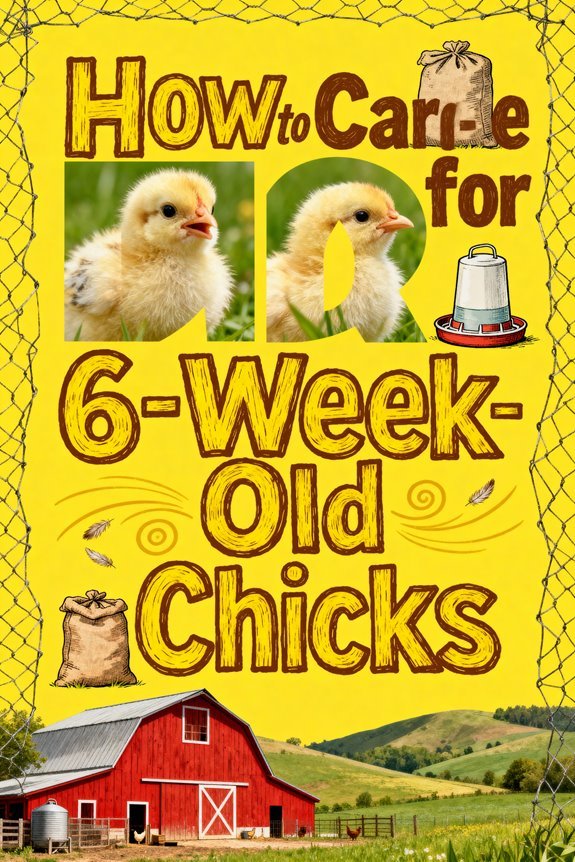How to Care for 6-Week-Old Chicks
At six weeks old, your chicks need a brooder temperature of 70°F/21°C as they prepare for outdoor living. Provide ¾ square foot per chick in their enclosure with 2 inches of bedding and 1-inch diameter perches. Shift to grower feed with 18-20% protein, offering 1-2 ounces per chick daily. Monitor their health through daily checks of eyes, nostrils, and vents. Understanding these fundamental care requirements will help you master the next essential stages of chick development.
Temperature Requirements and Environmental Control
As your 6-week-old chicks approach maturity, maintaining proper temperature control becomes critical for their successful change to outdoor living. At this stage, set your brooder temperature to 70°F/21°C while preparing for the shift to ambient conditions. Through careful behavior observation, you’ll know they’re ready when they spend minimal time under heat sources and display active, content exploration. Since chicks become fully feathered around this time, their natural temperature regulation improves significantly.
Monitor outdoor temperatures before making the move. Your chicks need daytime temperatures above 65°F/18°C for ideal acclimation, though fully feathered birds can tolerate down to 30°F/-1°C once adapted. Effective temperature management requires gradual exposure to outdoor conditions. Start with brief periods in mild, dry weather, and guarantee their coop provides protection from wind, rain, and drafts. If nighttime temperatures drop below 36°F/2.2°C, consider temporary supplemental heating.
Living Space and Housing Setup
A proper living space setup forms the foundation for healthy 6-week-old chicks. As your birds approach coop change age, you’ll need to provide at least ¾ square foot of space per chick in their brooding enclosure. Install 1-inch diameter perches to encourage natural roosting behavior and exercise. Commercial brooding kits provide the safest housing options for your growing chicks.
Maintain 2 inches of appropriate bedding materials like pine shavings or hemp bedding, avoiding cedar which can cause respiratory issues. You’ll need to change the bedding frequently to prevent pathogen buildup and use water-vinegar solutions for sanitization. Position feeders and waterers strategically to prevent crowding, and guarantee proper ventilation while avoiding drafts. If you’re using a square enclosure, block the corners to prevent suffocation from crowding. Monitor for aggressive behavior and separate problematic birds when necessary. Consider using aluminum frames for a more permanent and predator-resistant housing solution as your chicks mature. Planning ahead for your flock’s adult housing needs will require nesting boxes at a ratio of one box for every 3-4 hens.
Nutrition and Feeding Guidelines
Proper nutrition sets the foundation for robust growth in 6-week-old chicks. You’ll need to change from starter feed to grower feed, ensuring protein sources maintain levels between 18-20%. Provide feed continuously, targeting 1-2 ounces per chick daily, or approximately one pound per week per bird.
Supplement their diet with carefully selected treats like oats, yogurt, and leafy greens, but maintain proper feeding ratios – treats shouldn’t exceed 10% of their daily intake. You must provide fresh, clean water at all times, using metal waterers to prevent leaks and drowning risks. Select organic chick feed to ensure better nutritional value and reduce exposure to harmful chemicals or toxins. If your chicks don’t have access to natural ground, offer separate grit to aid digestion. Monitor their consumption patterns and adjust accordingly, especially during weather changes or increased activity levels.
Health Checks and Disease Prevention
While 6-week-old chicks show increasing independence, daily health monitoring remains critical for early disease detection and prevention. You’ll need to inspect each bird’s eyes, nostrils, and vents for abnormalities, while monitoring their movements for any signs of limping or wing irregularities. Installing roosts for perching is essential at this age to promote natural behaviors and proper foot health.
Focus on disease recognition by checking droppings regularly and listening for respiratory symptoms. Clean waterers daily, disinfect feeders, and maintain dry bedding to prevent bacterial growth. If you’re using medicated starter feeds with amprolium, verify they align with your vaccination protocols to avoid complications. Consider giving weaker birds an Epsom salt bath to support muscle health and improve circulation. Provide access to diatomaceous earth dust baths to naturally prevent parasitic infestations.
Watch for warning signs including eye discharge, nasal congestion, or behavioral changes. Isolate sick birds immediately, and maintain proper spacing between chicks to minimize disease transmission. Check feet regularly for bumblefoot and monitor beaks for feeding difficulties.
Social Development and Behavioral Monitoring
Six-week-old chicks enter a critical phase of social development marked by increased activity, complex interactions, and early pecking order establishment. You’ll notice heightened exploratory behaviors, play-fighting, and group foraging as they build social bonds within the flock. Monitor their vocal communication patterns, which now include distinct calls for alarm, contentment, and hunger. Their enhanced foraging abilities demonstrate proper pecking and foraging development as they search for diverse food sources.
Watch for signs of healthy social hierarchy formation through wing-flapping, head bobbing, and brief skirmishes. Provide adequate space and enrichment items to encourage natural behaviors while preventing overcrowding-related stress. Consider installing perch levels to help establish natural social dynamics within the growing flock. You’ll need to observe how your chicks respond to environmental changes and interact with flockmates. Look for consistent engagement in social activities and decreased fearfulness of handlers as indicators of proper development. Address any isolated or overly aggressive behaviors promptly to maintain flock harmony. At this stage, begin planning for their complete layer feed transition which will be crucial as they approach laying age.
Preparing for the Move Outdoors
As your chicks master their social dynamics, it’s time to focus on their next major milestone: moving outdoors. Begin by implementing thorough predator prevention measures, sealing all coop gaps with wire mesh and installing a protection kit for enhanced security. When planning treats for your new outdoor flock, remember that fresh cranberries provide beneficial vitamins while avoiding sugary versions. Transitioning to layer feed formulas will provide essential amino acids for proper development.
Start the brooder changeover by gradually reducing heat levels one week before the move. Your chicks must be fully feathered and at least six weeks old, with nighttime temperatures consistently above 50°F. Set up the coop with familiar feeders and waterers, ensuring at least 2 square feet per bird. You’ll need proper ventilation and insulation for temperature control. Consider using heated roosting posts instead of traditional heat lamps for safer temperature management.
Let your chicks explore their new environment during daylight hours initially. Consider relocating the brooder into the coop temporarily to maintain familiarity while monitoring their adjustment to outdoor conditions.
Essential Safety Measures and Protection
Three essential safety measures form the foundation of protecting your 6-week-old chicks: proper temperature control, secure housing, and vigilant predator prevention. At this age, maintain temperatures around 70°F while ensuring draft-free conditions. Your chicks still need protection from extreme weather and temperature fluctuations. Remember to decrease temperatures by 5°F weekly as your chicks continue to grow. Watch for chicks spreading out evenly as this indicates they’re at a comfortable temperature.
For maximum chick safety, install secure locks on all coop doors and reinforce any potential entry points with hardware cloth. Predator protection requires multiple layers of defense – sturdy fencing buried at least 12 inches deep, covered runs, and motion-activated lighting systems. Don’t leave food out overnight, as it attracts unwanted visitors. Regular coop sanitation is crucial to prevent stress and disease that can impact your growing flock.
Monitor your flock regularly for signs of distress or unusual behavior that might indicate a security breach. Keep emergency supplies and backup heating options readily available.




